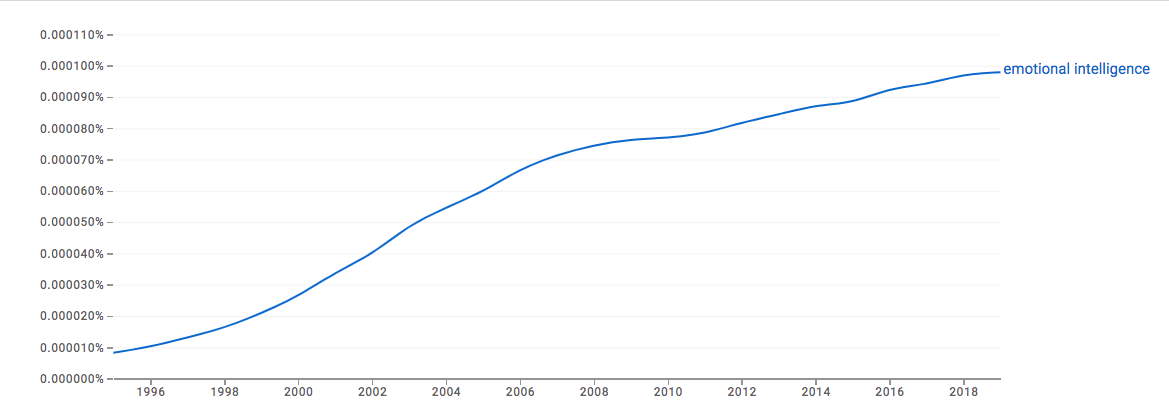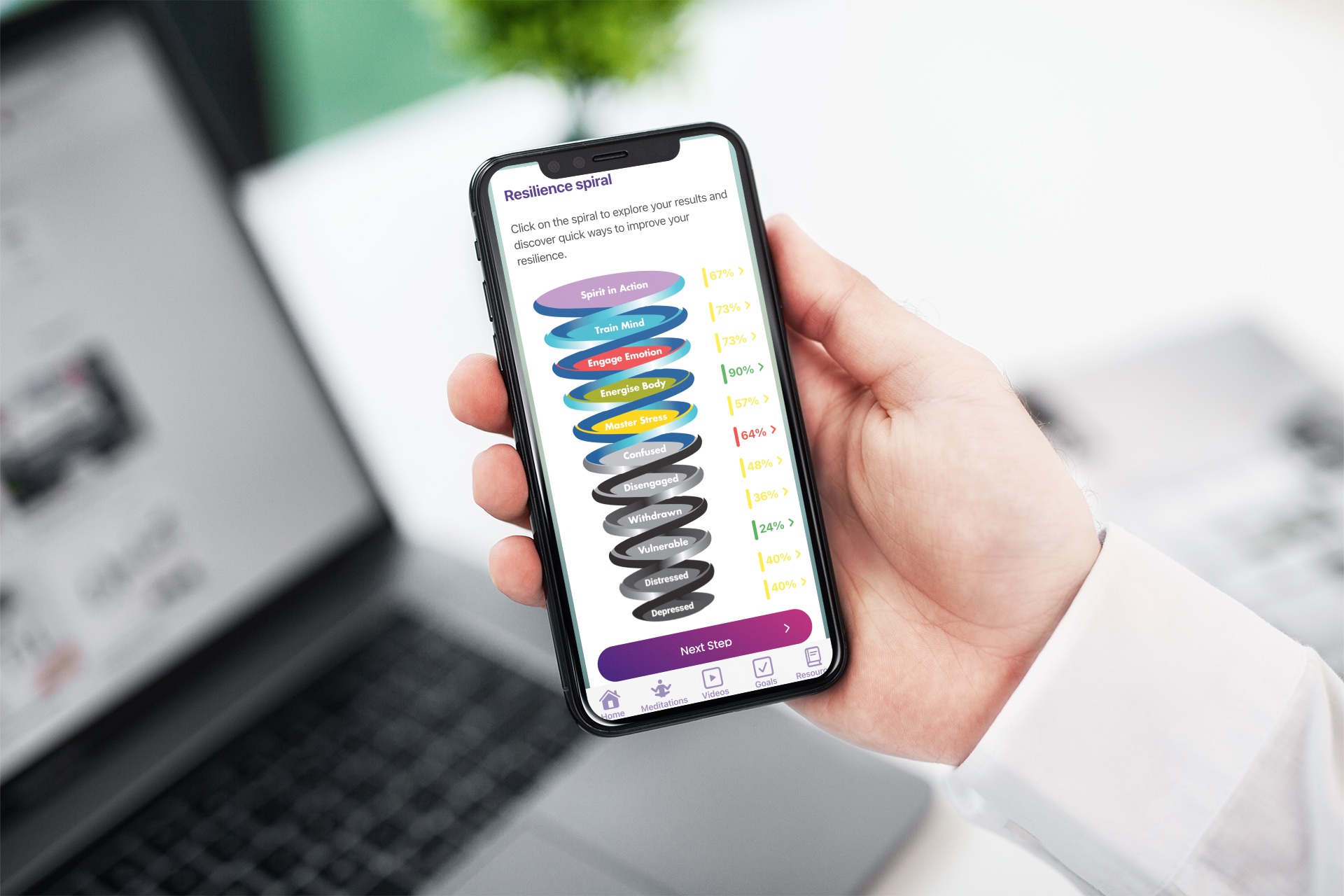
How and Why to Measure Emotional Intelligence in The Workplace?
The term emotional intelligence is perhaps one of the trendiest buzzwords in modern organizational psychology. Since author Daniel Goleman first published the book by the same name in 1995, the term ‘emotional intelligence’ has seen exponential growth in terms of how many times it has been referenced in the printed English corpus. The book has also been translated into over 40 languages globally.

I recall a longstanding billboard that sits on the northbound side of the 101 highway as you drive into San Francisco, California that shows a picture of a businessman dressed in a suit who holds a digital tablet — as if to measure something. The text of the billboard read something along the lines of “What is your team’s emotional intelligence?”
Emotional intelligence has quickly climbed the charts of organizational needs. Starting in 2016, the World Economic Forum estimated that by 2020 emotional intelligence would be the 6th most important skill for the future of work. Just last year in 2022, Forbes bumped emotional intelligence up to 3rd on that list. In fact, emotional intelligence is so popular in big business that an offshoot emotional intelligence specialist — author of “Emotional Intelligence 2.0” Travis Bradberry — supplies emotional intelligence assessments to some 3 out of 4 Fortune 500 companies.
The rapid ascension and adoption of emotional intelligence is one of the largest takeovers in the business world since the Myers Briggs Type Indicator — a “personality test” that’s nonetheless used in corporate coaching and hiring practices in Fortune 500 companies. You might wonder if the hype behind emotional intelligence is justified.
Why should you measure emotional intelligence in the workplace?
Emotional intelligence is a skill that is not only growing in importance, but need. Employers are actively seeking workers with soft skills like emotional intelligence to better navigate the future of work. In a very real way, machines are becoming more and more integrated into business and the consumer experience. From intelligent assembly machines to customer service chatbots, the workplace is becoming automated. That’s why soft skills like emotional intelligence are on the rise, or as McKinsey & Company penned it, there’s a need for “soft skills for a hard world.”
Here’s three reasons why your organization should start measuring emotional intelligence.
From the top
With so many claims of emotional intelligence being a proper asset for Fortune 500 companies, you would expect to find a few quotes floating around. You would be correct. CEO of Microsoft Satya Nadella praises the emotional intelligence index created by Goleman, noting that the empathy competency helps make people better at innovation.
Amazon creator Jess Bezos once said that smart people show examples of high emotional intelligence because they remain “open to new points of view, new information, new ideas, contradictions, and challenges to their own way of thinking.”
The CEO of Google, Sundar Pichai, also places a high value on emotional intelligence at the workplace. Pichai told Inc.,”You’re not just a manager. You’re a coach, trying to get the best out of others. It’s about empowering other people to succeed… To lead effectively, you have to understand the person you’re working with, not just the role they play.”
And those who champion emotional intelligence also have the numbers to back up the talk.
By the numbers
Here’s a look at the statistics behind the efficacy of emotional intelligence:
- According to a report by New Carat, Google, Microsoft, and Amazon rank in the top 10 for the most emotionally intelligent companies. Others include Visa, Samsung, Adidas, PayPal, Nike, Netflix, and Disney
- 71% of hiring managers value emotional intelligence over general intelligence (IQ)
- Empathy, the top leadership skill, can improve performance by 40% in coaching, engaging others, and decision-making
- Emotional intelligence accounts for 58% of job performance
- Goleman’s original research claims that emotional intelligence accounts for some 90% of difference in profile attributes of star leadership performers, rather than general intelligence or personality.
Backed by science
According to Daniel Goleman, emotional intelligence is the inborn human capacity to recognize one’s emotions and the emotions of others, while emotional competencies are the learnable capabilities that build on emotional intelligence and are critical for work performance.
The first part of his statement — about the recognition of emotions in ourselves and others being inborn — can be summed up by two quotes by renowned neuroscientist Lisa Feldman Barrett, “Emotions are not reactions to the world; they are your constructions of the world,” and “It takes more than one human brain to create a human mind.” Barrett shows how our emotions are not only recognizable to ourselves, they actually create our own worldview. We are then able to recognize emotions in others, and their worldviews. The second part of Goleman’s definition is captured in this quote by renowned neuroscientist Joseph Ledoux, “Emotions are a critical source of information for learning.” In short, Goleman’s concept of emotional intelligence is rooted in science.
Emotions have been the subject of scientific inquiry for centuries. Even Charles Darwin had a theory of human emotion. Such a longstanding inquiry means that scientists have been studying emotional intelligence for a long time, even though they didn’t come up with such a catchy phrase. For example, psychologist Reuven Bar-On writes in an oft cited 2006 review published in the journal Psicothema that Edward Thorndike’s studies on social intelligence in the 1920s mark the early components of emotional intelligence. It is no coincidence that Goleman’s assessment for emotional intelligence, the ESCI, measures emotional and social competencies.
In the 21st century emotional intelligence has continued to peak researcher interest. Goleman’s claim in the last By the numbers section — that emotional intelligence predicts performance at work better than other measures like general mental ability or personality — was verified by business professors Druskat and Jordan in 2007. Another concept researchers have linked to emotional intelligence is resilience, or our ability to adapt to change and stress. A 2013 study published in the journal Personality and Individual Differences found that emotional intelligence promotes resilience to stress, which means that resilience is an aspect of emotional intelligence.
How to measure emotional intelligence in the workplace
Intuitively, we all know what emotional intelligence is. But relying on intuition alone can lead people to have biased viewpoints. That’s where an assessment comes into play. Assessments enable people to work with coaches to give their personal point of view on their particular skill set and compare it to a group of others’ perceptions of the individual’s skillset. This is known as the 360 assessment — and it can be applied to an organization as well.
If you want to measure emotional intelligence with individuals in your organization, or even the organization as a whole, then you have a few options. Goleman worked with other industry experts to form the Emotional and Social Competence Index (ESCI). The assessment uses the 360 aspect to compare a self survey to the perspective of a group of raters on several core emotional intelligence competencies that fall under the major categories self-awareness, self-management, social awareness, and relationship management.
The individual can learn how to develop — notably this tool is designed for development only — certain competencies like how to accurately identify their own emotions, how to assess one’s skills, how to control emotions, how to be resilient, how to be empathetic towards others, how to develop organizational awareness, how to manage conflict, and how to collaborate and work with others better.
You can preview the finer details of the ESCI in the technical manual. Korn Ferry currently offers a comprehensive certification course for about $1,800 if you are interested in becoming certified. If you are looking for a way to access the assessment for your organization, Korn Ferry offers the assessment for about $300. Notably, delivery and feedback of the assessment requires a certified practitioner.
There are other options out there for measuring emotional intelligence. Here are a few other examples.
The Resilience Assessment — created by us the Resilience Institute — contains an entire category, “Engage Emotion,” and five specific factors relating to emotional intelligence. Additionally, the toolkit provides insights into emotional risk factors within the Categories “Withdrawn” and “Vulnerable.” When placed within the context of our holistic model the connections between safety, well-being, EQ skills and high performance can clearly be mapped.
The Resilience Assessment provides individuals with blueprints of their EQ and resilience skills, while providing leaders with maps detailing strengths and risks across the team.

The Team Emotional Intelligence Assessment — created by Druskat and Wolff — can provide you with the overall perspective of the member’s perceptions of the team. According to the assessment’s technical manual, it can help individuals better understand other team members, help the team solve problems and build optimism, and also help build external relationships.
The MacCann and Roberts Situational Test of Emotional Understanding (STEU) and Situational Test of Emotion Management (STEM) are situational judgment tests that view Emotional Intelligence as a cognitive ability. The STEU describes a situation and asks the testee to choose one of 5 emotions for an answer. The STEM details an emotional situation and then gives 4 choices. The best answer will be the most effective course of action to “manage both the emotions the person is feeling and the problem they face in the situation.”
Whether you are interested in development or performing research, there are many options for measuring emotional intelligence in the workplace,
What does emotional intelligence look like at work?
To get a better understanding of how emotional intelligence plays out in the workplace, and why it is advantageous to cultivate it, let’s run through the same scenario twice. The first time, the group will not exercise emotional intelligence. Then, using the 4 main categories of Goleman’s theory — self-awareness, self-management, social awareness, and relationship management — we’ll explore how emotional intelligence measurement and coaching can improve the situation and the performance of the team.
Situation before emotional intelligence:
A leader of a team in an organization is hot tempered, and will get very upset if the team does not carry out their commands. Unfortunately, the leader has little awareness of their negative emotional input on the team, and certainly does not do much to regulate their own emotions when things don’t go as planned. Since emotions are contagious, they bleed into the team. Now the team members are quick to blow a fuse with one another and easily drift towards negative emotions. Unable to identify their influence on the team and its newly adopted behaviors, the leader lacks the social awareness to establish any healthy relationship practices with the team, and performance and satisfaction plummet.
This is not an uncommon scenario. In fact, if this scenario weren’t common, it’s doubtful that the coaching industry would be valued at over $15 billion dollars. Now let’s revisit that scenario after an emotional intelligence coach is brought in.
Situation after emotional intelligence:
After observing the leader’s and team’s behaviors for a few days, the coach administers the emotional intelligence assessment in a 360 format. The leader takes the self assessment and the team provides peer feedback on the leader. While the leader scored themselves highly in all categories, they are surprised to learn that the team holds much lower views of the leader. The coach works with the leader to identify the areas of weakness and works with them to develop their skills. After some time, the leader buys in and starts to take an honest assessment of their emotional intelligence.
Now the leader catches themselves when they are losing their patience, and instead of getting angry and yelling, the leader now reframes mistakes into learning opportunities. They have learned new breathing exercises to calm down when they get in the red. And the positive emotional contagion has changed the team dynamics. The members are more patient and working better together, which drives more results. The leader, once emotionally deficient in intelligence, now exercises self-awareness, self-management, social awareness, and relationship management to help the team perform better and make the workspace a better place. This is the power of emotional intelligence.
Conclusion
Emotional intelligence is a popular skill in organizational psychology. We are all born with the capacity to recognize emotions within ourselves and in others, but we must learn and train these competencies in order to maximize our performance in the workplace. Emotional intelligence can not only help the individual perform better, but also teams and organizations. Emotions can make or break the workplace — make sure your organization is on the right side of the divide.
